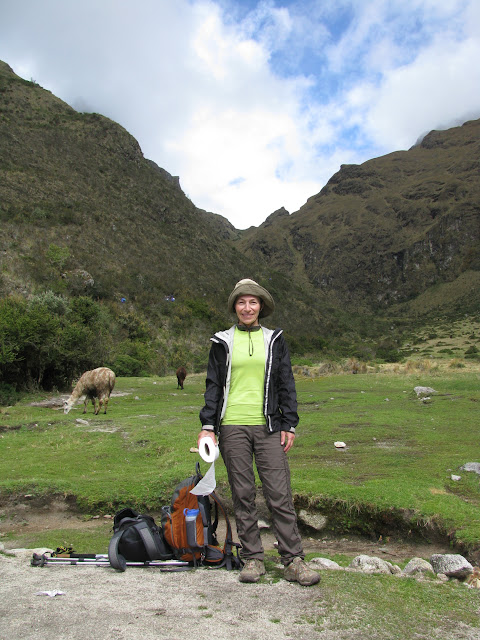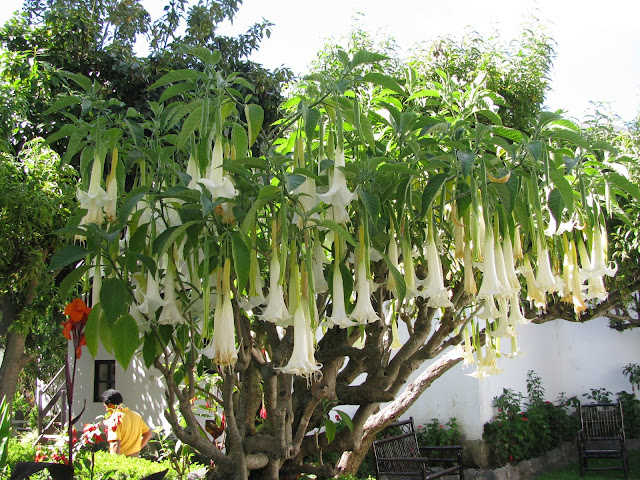Undeniably the most spectacular archaeological site on the continent, the ‘lost’ city of Machu Picchu tantalizes with its mysterious past and is deservedly world-famous for its stunning location and craftsmanship. We decide to get to it Incan-style by trekking 49.5 km and camping over four days on the Inca Trail with a group of like-minded adventurers.
Passports in hand, we clear the official Inca Trail check point, cross a suspension footbridge across the Urubamba River, and begin our trek with a gentle climb.
The ancient trail laid down by the Incas winds its way up, down and around mountains, snaking over three high passes en route. The views of snowy peaks and cloud forest are stupendous, and walking from one cliff-hugging ruin to the next is a mystical and unforgettable experience.
We have three hours on relatively level terrain as we follow the course of the river and are rewarded with superb views of Mount Veronica (5,750m) as we pass through a forest of giant cactus and native bushes.
A hearty lunch is welcomed by all.
After breakfast on Day 2 we depart from the camp around 7 a.m. This is our longest and hardest day, but one rewarded with spectacular views down several valleys and up to the surrounding snow-covered peaks. We put in a five-hour hike to reach our lunch camp in the Pacaymayo Valley, then another three to four hours to our night camp at Chakicocha. Sandi is armed and ready for a Andean loo-stop.
We begin with a 900m ascent up to the Warmiwanusca (Dead Woman’s) Pass at 4,200m. Along the way, we ascend steeply uphill where we see several species of birds. We soon enter a beautiful cloud forest and the treeless grasslands of the puna. The path climbs for two more hours along a large number of steps, some of them newly-laid to protect the mountain from erosion. This last hard climb brings us to Dead Woman’s Pass, the first of two that we will cross today.
We made it!
The porters, who rush past us continually on the trail, are unbelievably strong, carrying 25 kilos each.
Poles save the day and our knees as we have to hike up and down thousands of Inca steps all day long.
The head of a puma is seen through the mist in a rock formation.
Around mid-day on Day 3, we arrive at the site of Winaywayna, which we explore before completing a short additional hike to our camp site for the night (2,700m).
The view is our reward for what will be a tough night’s sleep on rocky ground at 3800m.

After lunch, we visit the adjacent site of Intipata with it’s dramatic terraces.
On Day 4 we get up at 3:30 a.m. and hike one and a half hours to get to Inti Punku (the Sun Gate), overlooking Machu Picchu for the first rays of the sunrise. When the early morning mist rises over the peaks and we begin to see the ruin’s granite stones row by row, Machu Picchu leaves us awestruck.
The Incas hid Machu Picchu so high in the clouds that the empire-raiding Spanish never found it. No longer overgrown with brush, as it was when it was discovered by Yale historin Hiram Bingham in 1911 with the aid of a local farmer who knew of its existence, it still cannot be seen from below. The majestic setting the Incas chose for their sacred city remains unchanged.
Invisible from the Urubamba Valley below, Machu Picchu lay dormant for more than four centuries, nestled nearly 2,400m above sea level under thick jungle and known only to a handful of Amerindian peasants. Never mentioned in the Spanish chronicles, it was seemingly lost in the collective memory of the Incas and their descendants. It’s unearthing raised more questions than it answered, and experts still argue over it’s purpose. Was it a citadel? An agricultural site? An astronomical observatory? A ceremonial city or sacred retreat for the Inca emperor? Or some combination of all of these? Adding to the the mystery, this complex city of exceedingly fine architecture and masonry was constructed, inhabited, and abandoned all in less than a century, a flash in the 4,000 year history of Andean Peru. It was probably abandoned even before the arrival of the Spanish, perhaps the result of the Inca’s civil war. Or perhaps it was drought that drove the Incas elsewhere.
The spectacular setting of Machu Picchu reveals just how much the Incas revelled in their environment. Steep terraces, gardens, granite and limestone temples, staircases, and aqueducts seem to be carved directly out of the hillside. Forms echo the very shape of the surrounding mountains, and windows and instruments appear to have been constructed to track the sun during the June and December solstices.
Down a steep series of stairs is one of the most famous Inca constructions, the Temple of the Sun. The rounded, tapering tower has extraordinary stonework, the finest in Machu Picchu. It’s large stones fit together seamlessly.
Beautiful trumpet flowers on native trees play to the majesty of the Andean mountains.
Stairs and rocks, rocks and stairs.
Fresh-sqeezed orange juice hits the spot on the Machu Picchu tourist trail.
After touring Machu Picchu and saying goodbye to our trekking group we take the train from Aguas Calientes to Ollantaytambo, a historic and lovely little place with snow-capped mountains that embrace the town. Most extraordinary are the precipitous, terraced ruins of a massive temple fortress built the Inca Pachacutec. Below the ruins, Ollantaytambo’s old town is a splendid Inca-grid of streets lined with adobe brick walls, blooming bougainvillea, and perfect canals, still carrying rushing water down from the mountains.
Tim tries on a traditional knitted mask used by locals at festivals and wonders if his Whistler Ski Team members would like one.
The temple ruins represent one of the Inca’s most formidable feats of architecture and are perhaps second only to Machu Picchu in their grandeur and harmony with the surrounding landscape.
We stay at El Albergue, an attractive and homey hostel right next to the train station, with great gardens and a wood-fired eucalyptus sauna to relax and recoup our tired everything.
A local harpist entertains us during dinner.
Pisco Sours, the national cocktail, are strong and definitely the order of night.
As is Alpaca steak with elderberry sauce.
Back in Cuzco, Sandi convinces Tim to try another Peruvian culinary specialty, Cuy, baked guinea pig, but Tim only remembers his childhood friend, Bertie the guinea pig, and has difficulty enjoying the meal.



















































































No comments:
Post a Comment